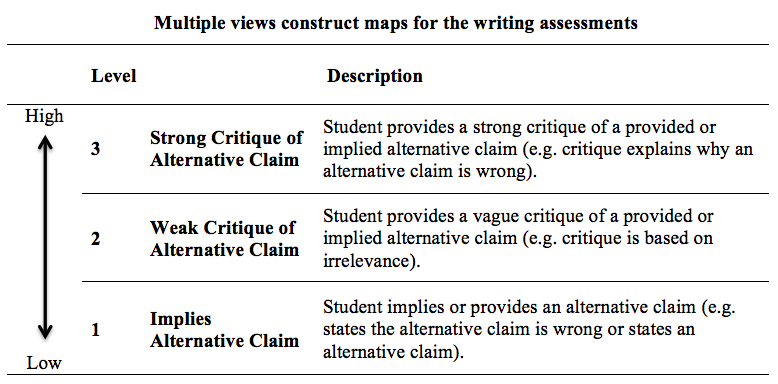multiple views
summaryThe purpose of the multiple views construct is to measure whether students recognize or critique alternative claims. This is an important skill because we want students to consider alternative explanations and be willing to change their minds in light of new evidence. Moreover, critiquing the evidence or reasoning of an alternative claim (i.e., constructing a rebuttal) makes an argument more persuasive because it demonstrates why your evidence and reasoning is stronger or of higher quality than other explanations. Not surprisingly, the literature suggests that constructing rebuttals is challenging for many students (e.g., Clark & Sampson, 2008; Osborne et al., 2004).
|
definitions
|
Construct map
A construct is a characteristic of an argument. Construct maps use research on student learning as well as expert knowledge to separate the construct into distinct levels that characterize students' progression towards greater expertise (Wilson, 2005). The writing multiple views construct map (see below) has three levels: 1) implies alternative claim 2) weak critique of alternative claim, and 3) strong critique of alternative claim.
assessments
We developed four different writing items. While the topic of two of the items focuses on earthquakes, the other two items focus on volcanoes. The students’ response to a writing item is used to place their ability at one of the levels on the construct map. For instance, if a student critiques the evidence for alternative claim, then he would be placed at the “strong critique” level of the multiple views construct map. However, multiple views is only 1 of 5 different ways the students’ written response will be assessed. In addition to multiple views, we encourage you to consider forms of justification, relevant-supporting evidence, sufficiency of evidence, and reasoning (maps and rubrics are provided for each). While the students’ of highest ability will score high on all of the constructs, students of lower ability levels may have different strengths and weaknesses.
rubrics
Each of the four items are constructed response. Therefore, we developed a rubric to grade/score each of the constructed response items. Each rubric includes sample student responses for each level.
teaching strategies
When first teaching student how to make and support an argument, it is natural for both the instruction and the students’ attention and cognitive efforts to be focused on what is needed to simply support the argument that they are choosing to support. Once students have mastered at least the introductory skills for doing this, you can guide them to also consider other, opposing arguments in their writing as well. Since science is a discipline built upon making arguments and explanations that takes into account competing claims and ideas, it is important that students understand how to think in this way. When students learn to first acknowledge and then critique arguments and evidence that are contrary to their own views, they will be using sophisticated and authentic practices of the discipline.
The Multiple Views Construct assumes, at Level 1, that students are already acknowledging another point of view in their writing. Levels 2-3 expect students to do more than acknowledge other points of view by offering critique. All three levels can be seen as students building capacity for this skill over time and with exposure and experience. The lessons and teaching strategies that follow map onto this, by offering a series of lessons that first establish a way of thinking about differing claims, evidence and points of view, then building from this so that students are encouraged to critique the opposing thinking in their own writing.
The Multiple Views Construct assumes, at Level 1, that students are already acknowledging another point of view in their writing. Levels 2-3 expect students to do more than acknowledge other points of view by offering critique. All three levels can be seen as students building capacity for this skill over time and with exposure and experience. The lessons and teaching strategies that follow map onto this, by offering a series of lessons that first establish a way of thinking about differing claims, evidence and points of view, then building from this so that students are encouraged to critique the opposing thinking in their own writing.
Construct Level
Levels 1-3
|
Description of Teaching Strategies
|
Resources
|
Tech reports
The tech report provides the psychometric analyses from pilot studies with middle school students.
references
Clark, D., & Sampson, V. (2008). Assessing dialogic argumentation in online environments to relate structure, grounds, and conceptual quality. Journal of Research on Science Teaching, 45(3), 293-321.
Osborne, J., Erduran, S., & Simon, S. (2004). Enhancing the quality of argumentation in school science. Journal of Research in Science Teaching, 41(10), 994-1020.
Osborne, J., Erduran, S., & Simon, S. (2004). Enhancing the quality of argumentation in school science. Journal of Research in Science Teaching, 41(10), 994-1020.

